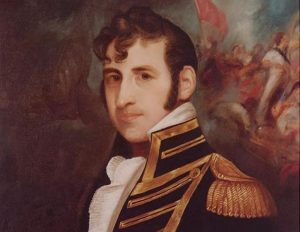
By Joseph F. Palmisano
Special To The Dispatch
BERLIN — A recent trip to the U.S. Naval Academy in Annapolis exposed me to the exploits of Stephen Decatur. Since he had ties to Worcester County, I decided to find out more about his naval hero and I wasn’t disappointed.
He was born in 1779 at Sinepuxent in Worcester County, the son of a naval officer who served in the Revolutionary War. After a brief stint at college, he joined the United States Navy at 19 years old. In the tumultuous early years of our country, he played a major role in the development of the American Navy.
He served under three presidents and was involved in almost every theater of operation during that era, showing exceptional heroism and leadership. He rose rapidly through the ranks and became the youngest person in the history of the U.S. Navy to achieve the rank of captain.
His initial trial by fire was in the Barbary Wars where he helped defeat the nest of pirates at Tripoli. Then he acted with honor in the quasi war with France and especially in the War of 1812 with Britain.
He was renowned for his leadership and genuine concern for the seamen under his command. His numerous victories over the French, British and Barbary states helped establish the United States as a rising power, able to take its place alongside the established great nations.
Subsequently he commanded many vessels and ultimately became a member of the Board of Naval Commissioners. He built a large home in Washington known as the Decatur House in Lafayette Square. He and his pretty wife, Susan, became the center of Washington society and counted President James Monroe and numerous other Washington dignitaries as their personal friends.
Decatur’s life and distinguished career in the U.S. Navy came to an early end in 1820 at the hands of disgraced Commodore James Barron. Because of past disagreements, Barron became embittered towards Decatur and challenged him to a duel. This occurred at a time when duels between officers were so common that it created a shortage of experienced officers, forcing the War Department to discharge those who attempted to pursue the practice, but it was too late to save Decatur.
Both men were wounded in the duel, but Decatur’s wound was mortal. He died later that evening.
Washington and the nation were shocked upon learning that Decatur was killed at the age of 41 in a duel with a rival naval officer at the pinnacle of his career and usefulness to our country.
His funeral was huge and attended by President Monroe, the justices of the Supreme Court and over 10,000 citizens of Washington.
His body was temporarily buried in Washington but was later moved to Philadelphia next to his parents at St. Peter’s Church.
At least 40 communities in America were named after him including Decatur, Ala., Decatur, Ga., Decatur, Ill. and Decatur, Texas. Stamps, ships, streets and other places were named in honor of Stephen Decatur. In the county of Worcester on the Eastern Shore of Maryland, a street, monument, park and middle and high schools were named after him.
It’s ironic that even though he is revered as a local hero, he left his area at a very early age and never returned.
(The writer is a retired physician who on a monthly basis will share insights about World War II and other historically significant events. The Ocean Pines resident is the author of “Doctor Joe, A Family Doctor In The Twentieth Century.”)
